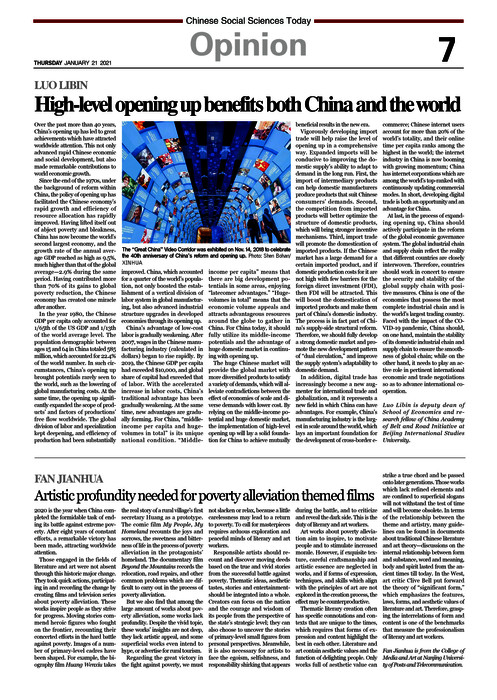Artistic profundity needed for poverty alleviation themed films
2021-01-19 15:52:21
2020 is the year when China completed the formidable task of ending its battle against extreme poverty. After eight years of constant efforts, a remarkable victory has been made, attracting worldwide attention.
Those engaged in the fields of literature and art were not absent through this historic major change. They took quick actions, participating in and recording the change by creating films and television series about poverty alleviation. These works inspire people as they strive for progress. Moving stories commend heroic figures who fought on the frontier, recounting their concerted efforts in the hard battle against poverty. Images of a number of primary-level cadres have been shaped. For example, the biography film Huang Wenxiu takes the real story of a rural village’s first secretary Huang as a prototype. The comic film My People, My Homeland recounts the joys and sorrows, the sweetness and bitterness of life in the process of poverty alleviation in the protagonists’ homeland. The documentary film Beyond the Mountains records the relocation, road repairs, and other common problems which are difficult to carry out in the process of poverty alleviation.
But we also find that among the large amount of works about poverty alleviation, some works lack profundity. Despite the vivid topic, these works’ insights are not deep, they lack artistic appeal, and some superficial works even intend to hype, or advertise for rural tourism.
Regarding the great victory in the fight against poverty, we must not slacken or relax, because a little carelessness may lead to a return to poverty. To call for masterpieces requires arduous exploration and peaceful minds of literary and art workers.
Responsible artists should recount and discover moving deeds based on the true and vivid stories from the successful battle against poverty. Thematic ideas, aesthetic tastes, stories and entertainmentshould be integrated into a whole. Creators can focus on the nation and the courage and wisdom of its people from the perspective of the state’s strategic level; they can also choose to uncover the stories of primary-level small figures from personal perspectives. Meanwhile, it is also necessary for artists to face the egoism, selfishness, and responsibility shirking that appears during the battle, and to criticize and reveal the dark side. This is the duty of literary and art workers.
Art works about poverty alleviation aim to inspire, to motivate people and to stimulate increased morale. However, if exquisite texture, careful craftsmanship and artistic essence are neglected in works, and if forms of expression, techniques, and skills which align with the principles of art are not explored in the creation process, the effect may be counterproductive.
Thematic literary creation often has specific connotations and contexts that are unique to the times, which requires that forms of expression and content highlight the best in each other. Literature and art contain aesthetic values and the function of delighting people. Only works full of aesthetic value can strike a true chord and be passed onto later generations. Those works which lack refined elements and are confined to superficial slogans will not withstand the test of time and will become obsolete. In terms of the relationship between the theme and artistry, many guidelines can be found in documents about traditional Chinese literature and art theory—discussions on the internal relationship between form and substance, word and meaning, body and spirit lasted from the ancient times till today. In the West, art critic Clive Bell put forward the theory of “significant form,” which emphasizes the features, laws, forms, and aesthetic values of literature and art. Therefore, grasping the interrelations of form and content is one of the benchmarks that measure the professionalism of literary and art workers.
Fan Jianhua is from the College of Media and Art at Nanjing University of Posts and Telecommunication.


